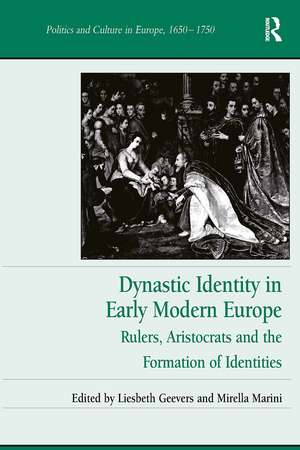Dynastic Identity in Early Modern Europe: Rulers, Aristocrats and the Formation of Identities: Politics and Culture in Europe, 1650-1750
Editat de Liesbeth Geevers, Mirella Marinien Limba Engleză Paperback – 14 oct 2024
| Toate formatele și edițiile | Preț | Express |
|---|---|---|
| Paperback (1) | 262.35 lei 6-8 săpt. | |
| Taylor & Francis – 14 oct 2024 | 262.35 lei 6-8 săpt. | |
| Hardback (1) | 1010.05 lei 6-8 săpt. | |
| Taylor & Francis – 28 noi 2015 | 1010.05 lei 6-8 săpt. |
Preț: 262.35 lei
Preț vechi: 312.65 lei
-16% Nou
Puncte Express: 394
Preț estimativ în valută:
50.20€ • 53.68$ • 41.86£
50.20€ • 53.68$ • 41.86£
Carte tipărită la comandă
Livrare economică 17 aprilie-01 mai
Preluare comenzi: 021 569.72.76
Specificații
ISBN-13: 9781032922652
ISBN-10: 1032922656
Pagini: 310
Dimensiuni: 156 x 234 mm
Greutate: 0.57 kg
Ediția:1
Editura: Taylor & Francis
Colecția Routledge
Seria Politics and Culture in Europe, 1650-1750
Locul publicării:Oxford, United Kingdom
ISBN-10: 1032922656
Pagini: 310
Dimensiuni: 156 x 234 mm
Greutate: 0.57 kg
Ediția:1
Editura: Taylor & Francis
Colecția Routledge
Seria Politics and Culture in Europe, 1650-1750
Locul publicării:Oxford, United Kingdom
Public țintă
AcademicCuprins
Avant-propos, Duc d’ Arenberg; Introduction: aristocracy, dynasty and identity in early modern Europe, 1520-1700, Liesbeth Geevers and Mirella Marini. Part I Identity, Ethnicity and Monarchy: Aristocratic identity formation in 17th-century Ireland, Jane Ohlmeyer; The newcomer’s dilemma: Henry IV of France and James I of England, Ronald G. Asch; Dynasty and elites: from early modern Europe to late imperial China, Jeroen Duindam. Part II Identity Formation and Family Relations: The Chièvres legacy, the Croÿ family and litigation in Paris. Dynastic identities between the Low Countries and France (1519-1559), Violet Soen; From Arenberg to Aarschot and back again: female inheritance and the disputed 'merger' of two aristocratic identities, Mirella Marini; Points of transferral: Mademoiselle de Guise’s will and the transferability of dynastic identity, Jonathan Spangler. Part III Manufacturing Identity: The fruits of war: the representation of Alessandro Farnese in Paolo Rinaldi’s Liber Relationum, Sebastiaan Derks; To give to airy nothing a local habitation and a name: creating two great Swedish noble families, Fabian Persson; The Nassau orphans. the disputed legacy of William of Orange and the construction of the Prince of Orange (1584-1675), Liesbeth Geevers; Conclusion: ‘The line of descent of nobles is from the blood of kings’: reflections on dynastic identity, Hamish Scott. Bibliography; Index.
Recenzii
"Although all of the contributions make for interesting reading, some aspects convey additional importance and thus deserve special notice. Take, for example, Duindam's article, which proposes comparisons between Europe and China on a truly grand scale, or Soen, who seems to pick up on issues of informality at court, a topic that also gained prominence in German scholarship in recent years." - Stephan Sander-Faes, University of Zurich, Switzerland
Notă biografică
Dr Liesbeth Geevers is a postdoctoral researcher at the Radboud University Nijmegen (Netherlands). From 2008 to 2011 she was a lecturer of Political History at Utrecht University. She has published on the dynastic identity of William of Orange in the 1560s and the identity of the Nassau dynasty (1541-1616) and is currently studying the position of dynastic juniors in Eurasian empires (1300-1800). Mirella Marini obtained a BA in Law (1996) and an MA in history (2006) at the KU Leuven (Belgium). Her doctoral research on the religious patronage of high noble women is undertaken at the VU University Amsterdam (Netherlands) and the University of Antwerp (Belgium). Marini has published on female diplomacy, funeral culture and the politics of dynastic marriages.
Descriere
Aristocratic dynasties have long been regarded as fundamental to the development of early modern society and government. Yet recent work by political historians has increasingly questioned the dominant role of ruling families in state formation, underlining instead the continued importance and independence of individuals. In order to take a fresh l

















